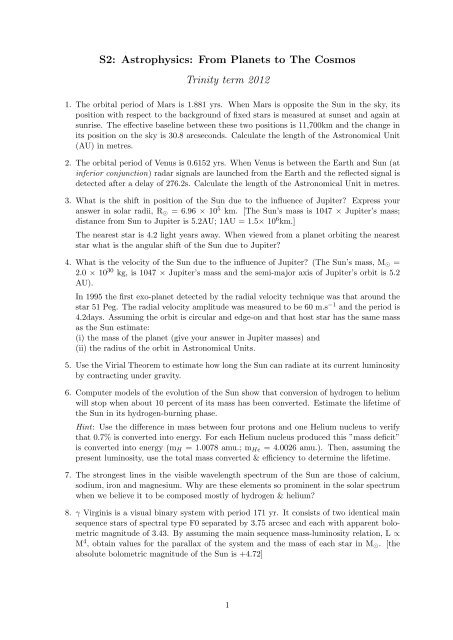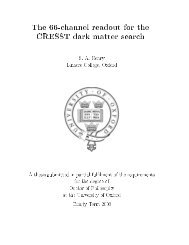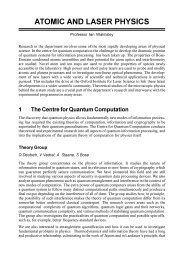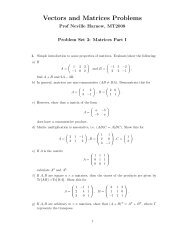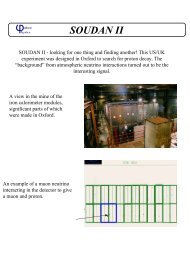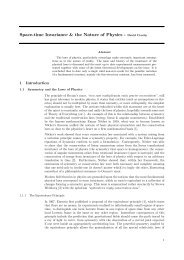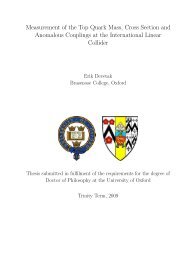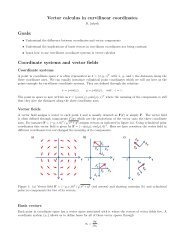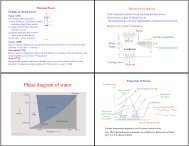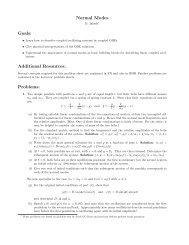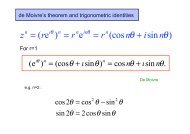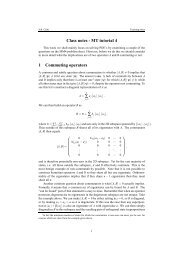S2: Astrophysics: From Planets to The Cosmos Trinity term 2012
S2: Astrophysics: From Planets to The Cosmos Trinity term 2012
S2: Astrophysics: From Planets to The Cosmos Trinity term 2012
You also want an ePaper? Increase the reach of your titles
YUMPU automatically turns print PDFs into web optimized ePapers that Google loves.
<strong>S2</strong>: <strong>Astrophysics</strong>: <strong>From</strong> <strong>Planets</strong> <strong>to</strong> <strong>The</strong> <strong>Cosmos</strong><br />
<strong>Trinity</strong> <strong>term</strong> <strong>2012</strong><br />
1. <strong>The</strong> orbital period of Mars is 1.881 yrs. When Mars is opposite the Sun in the sky, its<br />
position with respect <strong>to</strong> the background of fixed stars is measured at sunset and again at<br />
sunrise. <strong>The</strong> effective baseline between these two positions is 11,700km and the change in<br />
its position on the sky is 30.8 arcseconds. Calculate the length of the Astronomical Unit<br />
(AU) in metres.<br />
2. <strong>The</strong> orbital period of Venus is 0.6152 yrs. When Venus is between the Earth and Sun (at<br />
inferior conjunction) radar signals are launched from the Earth and the reflected signal is<br />
detected after a delay of 276.2s. Calculate the length of the Astronomical Unit in metres.<br />
3. What is the shift in position of the Sun due <strong>to</strong> the influence of Jupiter? Express your<br />
answer in solar radii, R ⊙ = 6.96 × 10 5 km. [<strong>The</strong> Sun’s mass is 1047 × Jupiter’s mass;<br />
distance from Sun <strong>to</strong> Jupiter is 5.2AU; 1AU = 1.5× 10 6 km.]<br />
<strong>The</strong> nearest star is 4.2 light years away. When viewed from a planet orbiting the nearest<br />
star what is the angular shift of the Sun due <strong>to</strong> Jupiter?<br />
4. What is the velocity of the Sun due <strong>to</strong> the influence of Jupiter? (<strong>The</strong> Sun’s mass, M ⊙ =<br />
2.0 × 10 30 kg, is 1047 × Jupiter’s mass and the semi-major axis of Jupiter’s orbit is 5.2<br />
AU).<br />
In 1995 the first exo-planet detected by the radial velocity technique was that around the<br />
star 51 Peg. <strong>The</strong> radial velocity amplitude was measured <strong>to</strong> be 60 m.s −1 and the period is<br />
4.2days. Assuming the orbit is circular and edge-on and that host star has the same mass<br />
as the Sun estimate:<br />
(i) the mass of the planet (give your answer in Jupiter masses) and<br />
(ii) the radius of the orbit in Astronomical Units.<br />
5. Use the Virial <strong>The</strong>orem <strong>to</strong> estimate how long the Sun can radiate at its current luminosity<br />
by contracting under gravity.<br />
6. Computer models of the evolution of the Sun show that conversion of hydrogen <strong>to</strong> helium<br />
will s<strong>to</strong>p when about 10 percent of its mass has been converted. Estimate the lifetime of<br />
the Sun in its hydrogen-burning phase.<br />
Hint: Use the difference in mass between four pro<strong>to</strong>ns and one Helium nucleus <strong>to</strong> verify<br />
that 0.7% is converted in<strong>to</strong> energy. For each Helium nucleus produced this ”mass deficit”<br />
is converted in<strong>to</strong> energy (m H = 1.0078 amu.; m He = 4.0026 amu.). <strong>The</strong>n, assuming the<br />
present luminosity, use the <strong>to</strong>tal mass converted & efficiency <strong>to</strong> de<strong>term</strong>ine the lifetime.<br />
7. <strong>The</strong> strongest lines in the visible wavelength spectrum of the Sun are those of calcium,<br />
sodium, iron and magnesium. Why are these elements so prominent in the solar spectrum<br />
when we believe it <strong>to</strong> be composed mostly of hydrogen & helium?<br />
8. γ Virginis is a visual binary system with period 171 yr. It consists of two identical main<br />
sequence stars of spectral type F0 separated by 3.75 arcsec and each with apparent bolometric<br />
magnitude of 3.43. By assuming the main sequence mass-luminosity relation, L ∝<br />
M 4 , obtain values for the parallax of the system and the mass of each star in M ⊙ . [the<br />
absolute bolometric magnitude of the Sun is +4.72]<br />
1
Figure 1: <strong>The</strong> primary minimum in the light curve of the eclipsing binary system AR Lacertae,<br />
plotted as a function of phase (i.e. fraction of period). This system, whose period is 1.98 days<br />
is also a spectroscopic binary: the radial velocity curves of the two components are sinusoidal<br />
and have amplitudes of 116km s −1<br />
9. AR Lac is an eclipsing spectroscopic binary with period 1.98 days. <strong>The</strong> radial velocity<br />
curves of the two stars are sinusoidal with equal amplitudes of 116km.s −1 . <strong>The</strong> diagram<br />
(Fig. 1) shows the primary minimum in the light curve as a function of orbital phase.<br />
De<strong>term</strong>ine the masses and radii of the two components. Assume the orbit is edge on.<br />
10. By equating the gravitational acceleration at the surface of a neutron star <strong>to</strong> the centrifugal<br />
acceleration at the equa<strong>to</strong>r, calculate the size of a 3M ⊙ neutron star that can spin with<br />
a period of 1ms without disintegrating. What is the density implied? Compare this with<br />
nuclear densities.<br />
11. A mass m falls <strong>to</strong>wards a black hole and ends up in an orbit at three Schwarzschild radii<br />
from the balck hole (this the closest stable orbit <strong>to</strong> the black hole). Use the New<strong>to</strong>nian<br />
expression for the decrease in potential energy, and the assumption that half this decrease<br />
will be radiated away (from the Virial theorem), <strong>to</strong> estimate the fraction of the rest mass<br />
that will be radiated away in this process. How does that compare with the fraction of<br />
the rest mass released in the p-p chain that you calculated in Ques 6?<br />
2
12. <strong>The</strong> period-luminosity relation for Cepheid variable stars is:<br />
M V = −2.81LogP − 1.43 (1)<br />
where P is the period in days and M V is the absolute V-band magnitude. Cepheid variable<br />
stars are found in the M31 with a period of 31 days and an apparent V-band magnitude,<br />
m V = 18.6. Calculate the distance <strong>to</strong> M31 in kiloparsecs, assuming no absorption along<br />
the line-of-sight (either in M31 or the Milky Way).<br />
<strong>The</strong> radial velocity of M31 with respect <strong>to</strong> the Milky Way is -300km/s i.e. <strong>to</strong>wards the<br />
Milky Way. How do you interpret this?<br />
13. <strong>The</strong> star <strong>S2</strong> has an orbit around the Galactic Centre with a period of 15.9 years and a<br />
semi-major axis of 125 milli-arcsecs. Taking the distance <strong>to</strong> the Galactic Centre <strong>to</strong> be 8kpc<br />
calculate the mass of a compact object around which <strong>S2</strong> orbits.<br />
Sgr A* is the radio source at the centre of the Galaxy. When it it flares at X-ray wavelengths<br />
the flux increases by × 4 in 40 minutes. Estimate the size of the emitting region<br />
and compare it’s linear size <strong>to</strong> the semi-major axis of <strong>S2</strong>.<br />
14. <strong>The</strong> RAVE experiment measures the radial velocities of stars in the neighbourhood of the<br />
Sun and finds that the distribution of velocities implies an escape velocity from the Milky<br />
Way (at 8kpc radius) in the range 430-560 km.s −1 . What mass range interior <strong>to</strong> 8kpc do<br />
you estimate from this measurement?<br />
15. <strong>The</strong> Tully-Fisher relation calibrated from Hubble Space Telescope measurements of Cepheid<br />
variable stars in local galaxies is:<br />
M V = −7.8(log∆v − 2.5) − 20.5 (2)<br />
where M V is the absolute magnitude of the galaxy in the V-band and ∆v is the full<br />
width of the observed integrated line profile of neutral hydrogen emission. For the spiral<br />
galaxy NGC 3198 the width of the HI profile, ∆v = 300 km.s −1 , and the apparent V-band<br />
magnitude, m V = 10.4. Calculate the distance <strong>to</strong> NGC3198 in Mpc.<br />
<strong>The</strong> recession velocity of NGC3198 is 680 km.s −1 , what value of the Hubble constant is<br />
implied? If in fact H 0 = 72 km.s −1 .Mpc −1 what conclusion do you draw?<br />
16. A rich cluster of galaxies of radius 2Mpc contains 1000 elliptical galaxies with average<br />
luminosity 10 10 L ⊙ . An analysis of the colours and spectra of typical elliptical galaxies<br />
indicates that on average it takes 3M ⊙ <strong>to</strong> generate one L ⊙ . <strong>The</strong> rms velocity of galaxies<br />
in the cluster is 1300 km.s −1 . Make an estimate of the mass of the cluster. Compare the<br />
<strong>to</strong>tal mass in galaxies with mass of the cluster. What possibilities are suggested by this<br />
result?<br />
17. <strong>The</strong> present mass density of the Universe is 2.5 × 10 −27 kg.m −3 (about 2 pro<strong>to</strong>ns m −3 ) and<br />
the present day energy density in CMB pho<strong>to</strong>ns is 5 × 10 5 eV.m −3 . Compare the energy<br />
density in matter with the energy density in the CMB radiation <strong>to</strong>day, and calculate the<br />
redshift at which the two energy densities were equal.<br />
3


